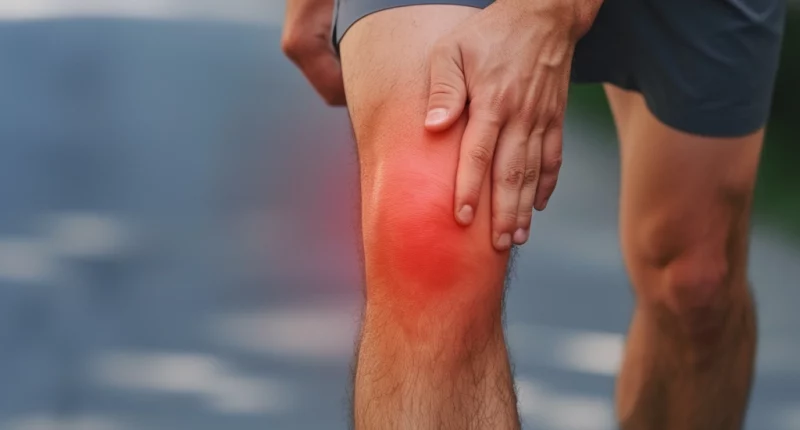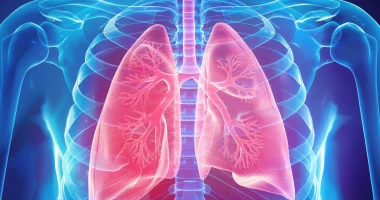Knee bursitis
What’s that?
Knee bursitis is an inflammatory lesion of the periarticular bursae localized in the knee region.
About the disease
The pathological process can be a manifestation of both local and systemic disease. For a long time, knee bursitis was especially common in representatives of certain professions, particularly tile and parquet installers. These specialists at work have to rest their knees for a long time, which was accompanied by microtraumatization.
In the presence of favorable factors, the articular bag is easily inflamed, which is associated with a unique anatomical structure. Thus, the bursa is represented by a narrow slit-like space lined with a synovial membrane. The articular pouch is a limited formation that produces synovial fluid. These features create conditions for almost unimpeded penetration of pathogens.
Types of knee bursitis
By the nature of the course of the inflammatory process, there are three main types of bursitis of the knee joint:
- acute course, which is characterized by the development of an active inflammatory response;
- chronic course, in which periods of exacerbation are replaced by periods of remission (the inflammatory process may be activated by general and local hypothermia, concomitant pathologies, etc.);
- subacute course, which occupies an intermediate position between the two described above.
According to the nature of the inflammatory process, four forms of the disease are distinguished:
- serous – this is usually the initial stage, in which the inflammatory secretion is represented by plasma and also contains a small proportion of cellular components;
- purulent – develops if the pathological process continues to progress, which leads to the death of microorganisms and protective immune cells (the pus also contains dead cells of the affected organ);
- hemorrhagic – the released plasma has an exceptionally high number of red blood cells (the exudate may have a red and purple hue);
- fibrinous, which is characterized by a high content of fibrin.
As a rule, the fibrinous form is characteristic of the chronic course of the inflammatory process in the bursa.
According to the localization of the pathological process, the following types are distinguished:
- prepatellar bursitis;
- infrapatellar bursitis of deep and superficial localization;
- suprapatellar bursitis;
- Baker’s cyst.
Symptoms of knee bursitis
The main objective symptom of bursitis of the knee joint is the appearance of a rounded, dense, elastic swelling in the area of the mobile joint. This local swelling is painful when felt; the skin above it may be hot. The swelling fluctuates, i.e., backward thrusts of fluid are felt when pressure is applied.
The leading clinical sign of knee joint inflammation is pain syndrome. Pain can have varying degrees of severity, from moderate to intense. Pain is present at rest and increases with movement.
Depending on the localization of the swelling, the doctor can determine which knee joint bag is inflamed:
- Swelling in the hamstring area is characteristic of an inflammatory lesion of the semimembranous pouch (this process is also called Baker’s cysts); sometimes, the inflammatory tumor can reach a considerable size and move from the knee to the lower leg);
- Local swelling in the patellar region indicates inflammation of the prepatellar pouch;
- An inflammatory bilateral (lateral and medial) bulge around the patellar ligament is a sign of infrapatellar bursitis.
When the tendons of 3 muscles attached to the tibial bone become inflamed, pes anserinus bursitis develops (these three tendons form this anatomic structure). For the inflammatory process of this localization, the formation of limited swelling is not characteristic. The main manifestations of this disease are painful sensations during physical activity and localized pain when feeling the lower part of the knee.
In most cases, acute bursitis resolves within a week or two. However, sometimes, the inflammatory process progresses to the purulent stage. It is due to the attachment of pus flora. With a delayed appeal for medical help, pus quickly spreads to the surrounding tissues; there is partial or complete necrosis of the tissues of the inflamed bag, and phlegmonous foci are formed under the skin and between the muscles. In this situation, the clinical picture becomes significantly pronounced and severe. The following symptoms appear:
- body temperature’s rising;
- increased pain in the knee area;
- increasing general weakness and signs of intoxication.
Causes of knee bursitis
Local causes of knee bursitis may be due to the following factors:
- excessive stress on the knee;
- microtraumatization;
- tendon-ligament strain;
- abnormal structure of different parts of the musculoskeletal system, including kyphosis and scoliosis;
- direct blows to the knee area;
- infectious process that is accompanied by a bursa lesion.
Systemic factors that can lead to inflammation of the knee joint subscapularis may be the following:
- Autoimmune imbalance, such as in rheumatoid arthritis;
- Endocrine disorders (diabetes mellitus, reduced functional activity of the thyroid gland);
- Metabolic disorders (prolonged elevated blood lipid levels, persistent elevation of uric acid concentration);
- Allergic reactions may be accompanied by secondary involvement of periarticular joints in the pathological process.
Despite the variety of causative factors, the leading etiologic agent is mechanical trauma to the periarticular bursa. The infectious, metabolic, and intoxicating nature of the disease is much less common.
Diagnosis of knee bursitis
Diagnosis of knee bursitis is based on objective examination of the knee and additional visualization. The main methods of instrumental diagnostics are:
- Ultrasound of the knee – ultrasound scans help examine soft tissue structures, including periarticular bursae;
- MRI – the method is not accompanied by radiation exposure and allows obtaining layer-by-layer images of joint structures (primarily, joint bags, tendons, cartilage layers);
- CT scan – helps obtain layer-by-layer X-rays that evaluate bony and soft tissue structures.
The doctor prepares the optimal diagnostic program, taking into account the peculiarities of the clinical case.
Treatment of knee bursitis
According to clinical recommendations for bursitis of the knee joint, treatment begins with conservative therapy. If it is ineffective or complications develop, surgical intervention is indicated.
Conservative treatment
Treatment of the disease begins with the creation of functional rest of the affected joint; physical activity is limited, and walking with the use of an orthopedic cane is recommended.
Nonsteroidal anti-inflammatory drugs are used to relieve pain syndrome. These drugs can be prescribed both systemically and locally. After the acute process subsides, the treatment program includes physical procedures that accelerate recovery and have a complex effect on inflamed tissues. In the case of pronounced muscle hypertonus, which increases pain sensations, the drug therapy also includes myorelaxants. In some cases, intra-articular injections of anti-inflammatory drugs and hyaluronate are indicated.
Surgical treatment
Surgery for bursitis of the knee joint is not the primary treatment method. Surgical intervention is recommended only in case of a complicated disease course. The main indications are:
- purulent inflammation of the articular bag and surrounding tissues;
- development of a chronic process with the formation of periarticular cysts.
All these treatment options are available in more than 820 hospitals worldwide (https://doctor.global/results/diseases/knee-bursitis). For example, Arthroscopic treatment of prepatellar bursitis can be performed in 43 clinics across Germany for an approximate price of $6.9 K(https://doctor.global/results/europe/germany/all-cities/all-specializations/procedures/arthroscopic-treatment-of-prepatellar-bursitis).
Prevention
To reduce the risk of developing post-traumatic bursitis, it is important to follow exercise techniques, use protective kneepads in occupational hazards, and limit the emphasis on the knees.
Rehabilitation
After surgery, the knee must be immobilized for several weeks. For this purpose, a plaster cast may be applied. The comprehensive rehabilitation program includes physiotherapy, therapeutic massage, and recreational gymnastics.



